Expanding Moment Magnitude Pools for Earthquake Magnitude Homogenization
Abstract
:1. Introduction
2. Materials and Methods
2.1. Earthquake Catalog Construction
2.2. Magnitude Homogenization
2.3. Magnitude Pool Expansion
3. Results
3.1. Indonesia
3.2. South Korea
4. Discussion
5. Conclusions
Author Contributions
Funding
Institutional Review Board Statement
Informed Consent Statement
Data Availability Statement
Acknowledgments
Conflicts of Interest
References
- Das, R.; Wason, H.R.; Sharma, M.L. Global regression relations for conversion of surface wave and body wave magnitudes to moment magnitude. Nat. Haz. 2011, 59, 801–810. [Google Scholar] [CrossRef]
- Scordilis, E.M. Empirical global relations converting ms and mb to moment magnitude. J. Seism. 2006, 10, 225–236. [Google Scholar] [CrossRef]
- Weatherill, G.A.; Pagani, M.; Garcia, J. Exploring earthquake databases for the creation of magnitude-homogeneous catalogues: Tools for application on a regional and global scale. Geophys. J. Int. 2016, 206, 1652–1676. [Google Scholar] [CrossRef] [Green Version]
- Yee, E.; Park, W. Moment Magnitude Homogenization Relations in the South Korean Region from 1900 to 2020. Appl. Sci. 2022, 12, 7215. [Google Scholar] [CrossRef]
- Hanks, T.C.; Kanamori, H. A Moment magnitude scale. J. Geophys. Res. 1979, 84, 2348–2350. [Google Scholar] [CrossRef]
- Xu, J.G.; Feng, D.C.; Mangalathu, S.; Jeon, J.S. Data-driven rapid damage evaluation for life-cycle seismic assessment of regional reinforced concrete bridges. Earthq. Eng. Struct. Dyn. 2022, 51, 2730–2751. [Google Scholar] [CrossRef]
- Gasperini, P.; Lolli, B.; Vannucci, G.; Boschi, E. A comparison of moment magnitude estimates for the European—Mediterranean and Italian regions. Geophys. J. Int. 2012, 190, 1733–1745. [Google Scholar] [CrossRef] [Green Version]
- Das, R.; Sharma, M.L.; Wason, H.R.; Choudhury, D. A seismic moment magnitude scale. Bull. Seismol. Soc. Am. 2019, 109, 1542–1555. [Google Scholar] [CrossRef]
- Ekström, G.; Nettles, M.; Dziewonski, A.M. The global cmt project 2004–2010: Centroid-moment tensors for 13,017 earthquakes. Phys. Earth Planet. Int. 2012, 200–201, 1–9. [Google Scholar] [CrossRef]
- Frohlich, C.; Davis, S.D. How well constrained are well-constrained t, b, and p axes in moment tensor catalogs? J. Geophys. Res. 1999, 104, 4901–4910. [Google Scholar] [CrossRef]
- Kagan, Y.Y. Accuracy of modern global earthquake catalogs. Phys. Earth Planet. Inter. 2003, 135, 209. [Google Scholar] [CrossRef]
- Di Giacomo, D.; Bondár, I.; Storchak, D.A.; Engdahl, E.R.; Bormann, P.; Harris, J. ISC-GEM: Global instrumental earthquake catalogue (1900–2009), iii. re-computed ms and mb, proxy mw, final magnitude composition and completeness assessment. Phys. Earth Planet. Int. 2015, 239, 33–47. [Google Scholar] [CrossRef]
- Di Giacomo, D.; Storchak, D.A. A scheme to set preferred magnitudes in the ISC Bulletin. J. Seism. 2016, 20, 555–567. [Google Scholar] [CrossRef]
- Willemann, R.J.; Storchak, D.A. Data Collection at the International Seismological Centre. Seis. Res. Lett. 2001, 72, 440–453. [Google Scholar] [CrossRef] [Green Version]
- Storchak, D.A.; Harris, J.; Brown, L.; Lieser, K.; Shumba, B.; Verney, R.; Di Giacomo, D.; Korger, E.I.M. Rebuild of the bulletin of the international seismological centre (isc), part 1: 1964–1979. Geosci. Lett. 2017, 4, 32. [Google Scholar] [CrossRef]
- Storchak, D.A.; Harris, J.; Brown, L.; Lieser, K.; Shumba, B.; Di Giacomo, D. Rebuild of the bulletin of the international seismological centre (isc)—Part 2: 1980–2010. Geosci. Lett. 2020, 7, 18. [Google Scholar] [CrossRef]
- Di Giacomo, D.; Engdahl, E.R.; Storchak, D.A. The ISC-GEM Earthquake Catalogue (1904–2014): Status after the Extension Project. Earth Syst. Sci. Data 2018, 10, 1877–1899. [Google Scholar] [CrossRef] [Green Version]
- Storchak, D.A.; Di Giacomo, D.; Bondár, I.; Engdahl, E.R.; Harris, J.; Lee, W.H.K.; Villaseñor, A.; Bormann, P. Public release of the isc-gem global instrumental earthquake catalogue (1900–2009). Seismol. Res. Lett. 2013, 84, 810–815. [Google Scholar] [CrossRef] [Green Version]
- Storchak, D.A.; Di Giacomo, D.; Engdahl, E.R.; Harris, J.; Bondár, I.; Lee, W.H.K.; Bormann, P.; Villaseñor, A. The isc-gem global instrumental earthquake catalogue (1900–2009): Introduction. Phys. Earth Planet. Int. 2015, 239, 48–63. [Google Scholar] [CrossRef]
- USGS Earthquake Hazards Program US (Catalog). Available online: https://earthquake.usgs.gov/data/comcat/catalog/us/ (accessed on 29 October 2022).
- Sipkin, S.A. Rapid determination of global moment-tensor solutions. Geophys. Res. Lett. 1994, 21, 1667–1670. [Google Scholar] [CrossRef]
- USGS Earthquake Hazards Magnitude Types. Available online: https://www.usgs.gov/programs/earthquake-hazards/magnitude-types (accessed on 29 October 2022).
- Kim, S.K.; Park, M.A. The Local Magnitude Scale in the Korean Peninsula. Pure Appl. Geophys. 2005, 162, 875–889. [Google Scholar] [CrossRef]
- Sheen, D.H.; Kang, T.S.; Rhie, J.K. A Local Magnitude Scale for South Korea. Bull. Seismol. Soc. Am. 2018, 108, 2748–2755. [Google Scholar] [CrossRef]
- Pujols, J. Regression between earthquake magnitudes having errors with known variances. J. Seismol. 2016, 20, 1041–1056. [Google Scholar] [CrossRef]
- Helffrich, G.R. How good are routinely determined focal mechanisms? Empirical statistics based on a comparison of Harvard, USGS and ERI moment tensors. Geophys. J. Int. 1997, 131, 741–750. [Google Scholar] [CrossRef]
- Gasperini, P.; Lolli, B.; Vannucci, G. Body-Wave Magnitude mb is a Good Proxy of Moment Magnitude MW for Small Earthquakes (mb < 4.5−5.0). Seismol. Res. Lett. 2013, 84, 932–937. [Google Scholar]
- International Seismological Centre (ISC). Summary of the Bulletin of the International Seismological Centre, January–June 2018. ISC 2020, 55, 188. [Google Scholar]
- Pacheco, J.; Sykes, L.R. Seismic moment catalogue of large shallow earthquakes 1900–1989. Bull. Seism. Soc. Am. 1992, 82, 1306–1349. [Google Scholar] [CrossRef]
- Di Giacomo, D.; Harris, J.; Storchak, D.A. Complementing regional moment magnitudes to GCMT: A perspective from the rebuilt International Seismological Centre Bulletin. Earth Syst. Sci. Data 2021, 13, 1957–1985. [Google Scholar] [CrossRef]
- Kubo, A.; Fukuyama, E.; Kawai, H.; Nonomura, K. NIED seismic moment tensor catalogue for regional earthquakes around Japan: Quality test and application. Tectonophysics 2002, 356, 23–48. [Google Scholar] [CrossRef]

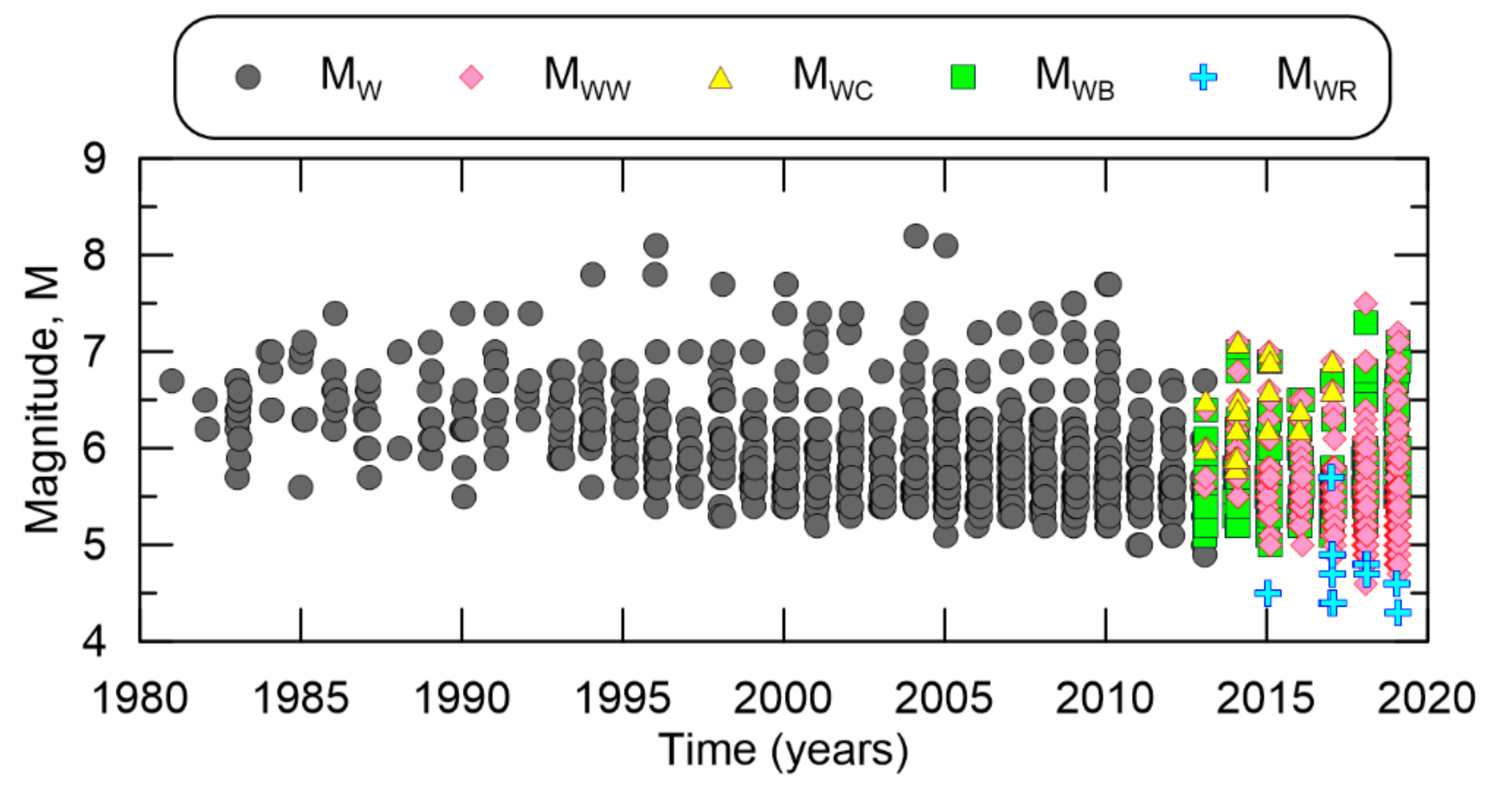

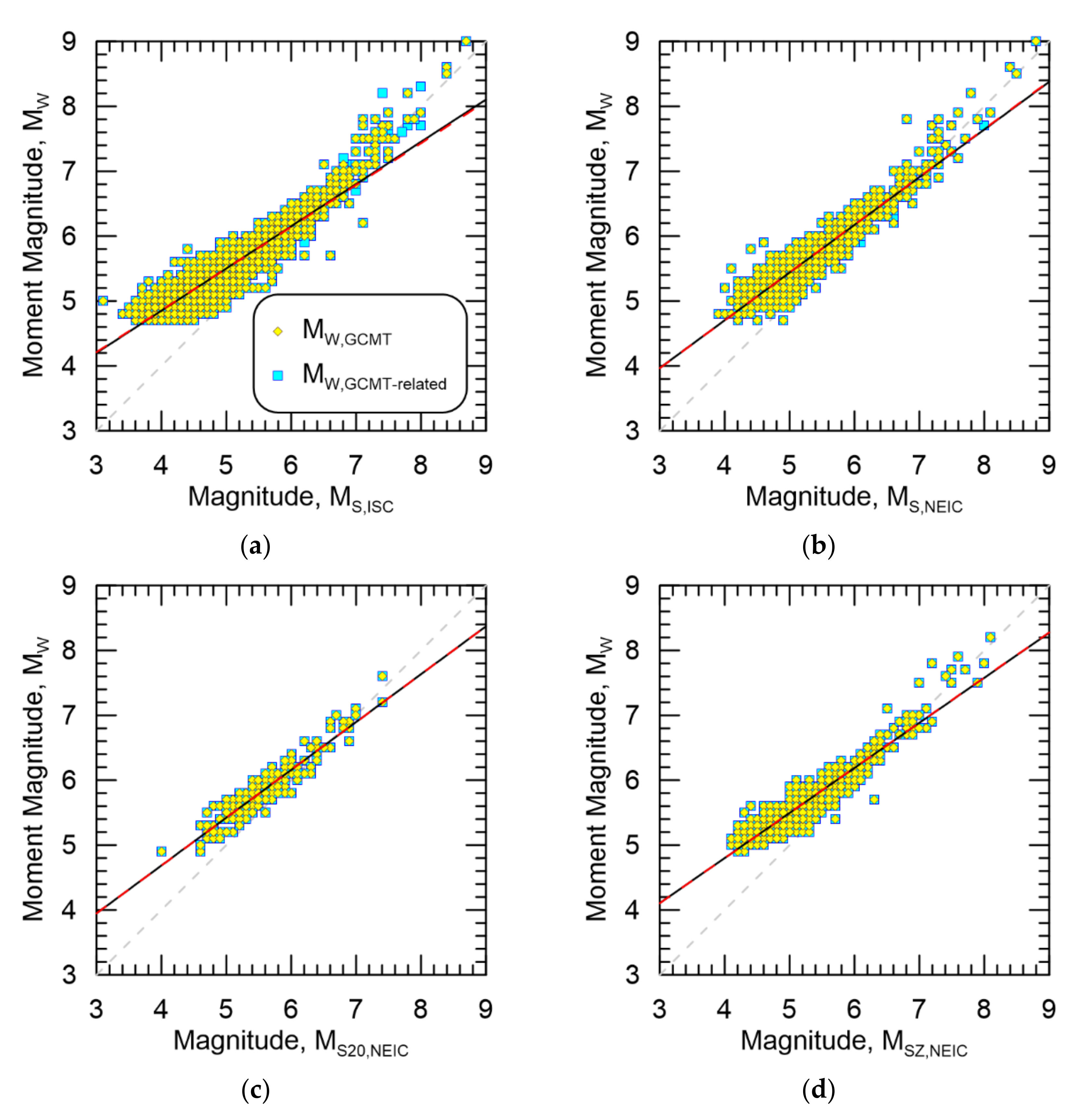

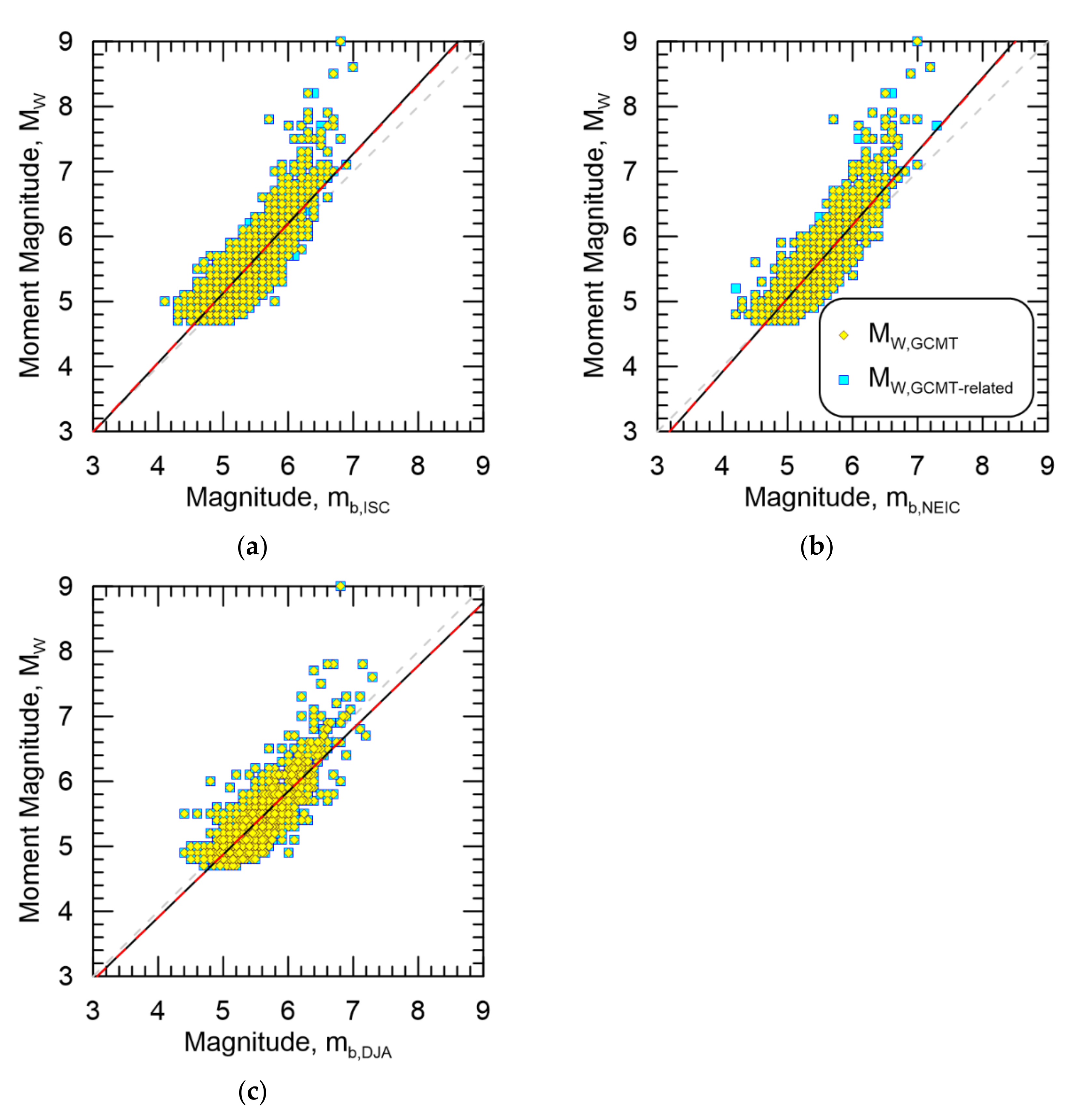


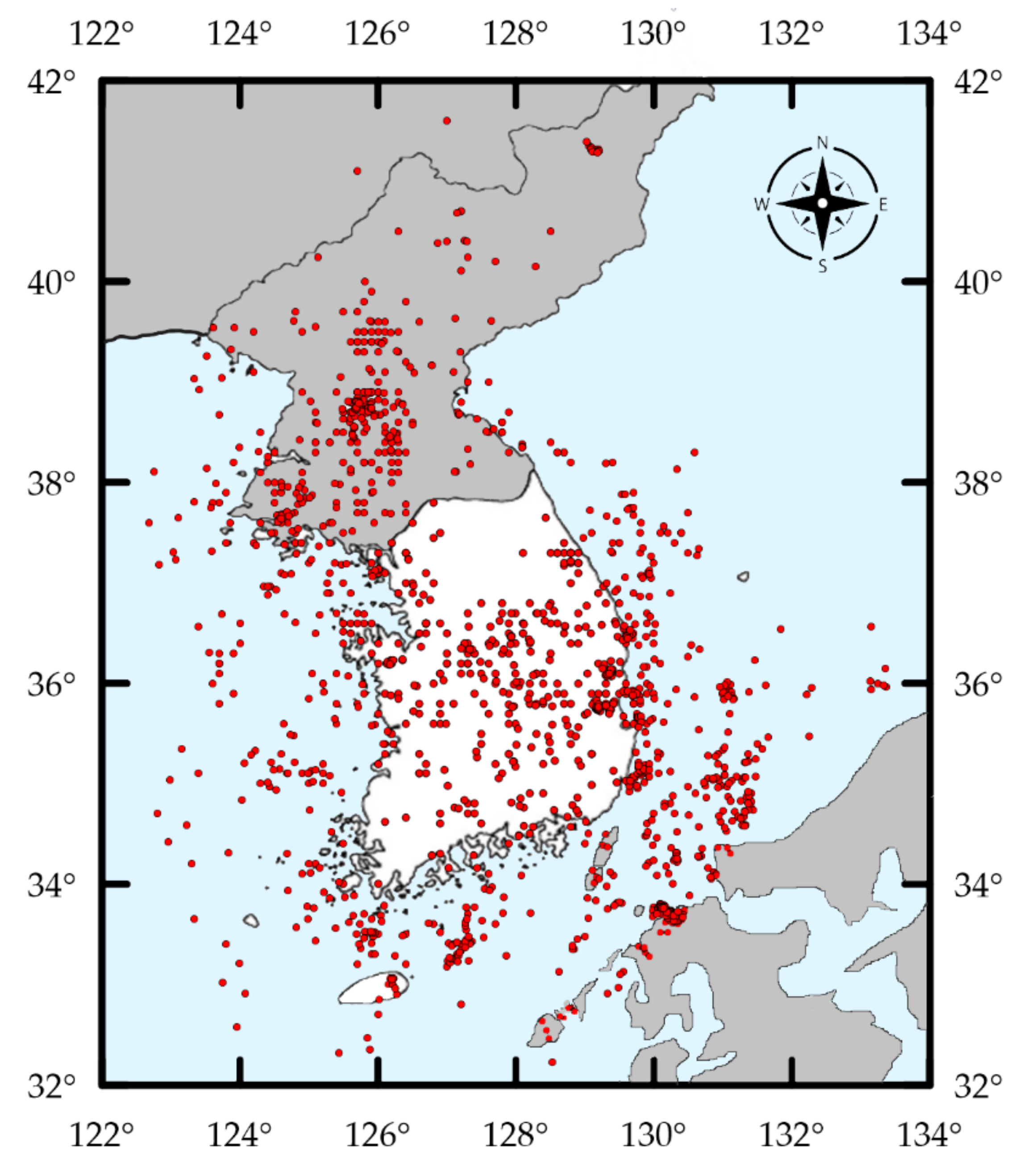

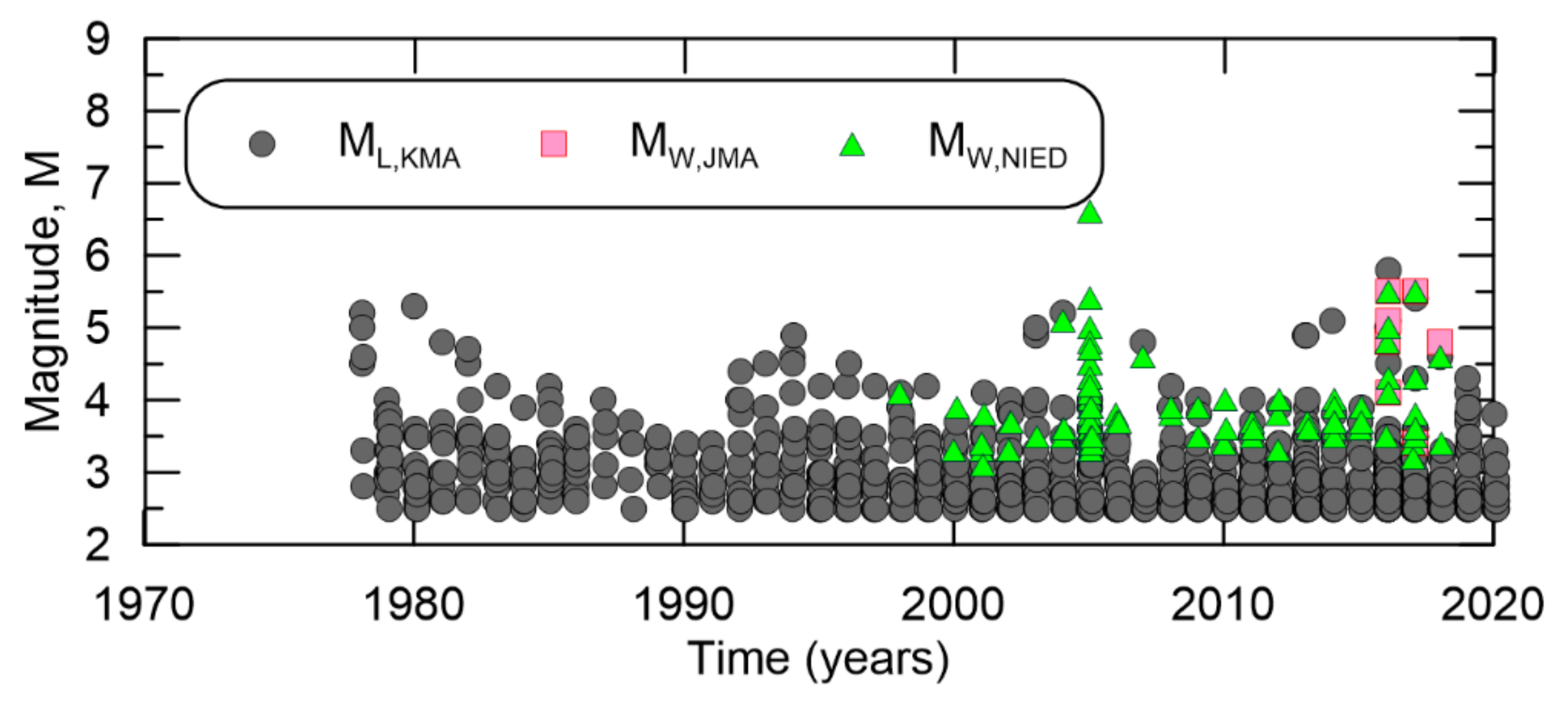



| Code | Agency | Country | Status |
|---|---|---|---|
| CGS | Coast and Geodetic Survey of the United States | U.S.A. | Inactive |
| DJA | Badan Meteorologi, Klimatologi dan Geofisika | Indonesia | Active |
| EVBIB | Data from publications listed in the ISC Event Bibliography | Unknown | Inactive |
| GCMT | The Global CMT Project | U.S.A. | Active |
| GS | U.S. Geological Survey | U.S.A. | Active |
| HRVD | Harvard University | U.S.A. | Inactive |
| IPGP | Institut de Physique du Globe de Paris | France | Active |
| ISC | International Seismological Centre | U.K. | Active |
| ISC-GEM | Global Instrumental Earthquake Catalogue | U.K. | Active |
| ISC-PPSM | International Seismological Centre Probabilistic Point Source Model | U.K. | Active |
| ISS | International Seismological Summary | U.K. | Inactive |
| JMA | Japan Meteorological Agency | Japan | Active |
| KMA | Korea Meteorological Administration | South Korea | Active |
| MOS | Geophysical Survey of Russian Academy of Sciences | Russia | Active |
| NEIC | National Earthquake Information Center | U.S.A. | Active |
| NEIS | National Earthquake Information Service | U.S.A. | Active |
| NIED | National Research Institute for Earth Science and Disaster Resilience | Japan | Active |
| P&S | Pacheco and Sykes catalog [29] | Unknown | Inactive |
| USCGS | United States Coast and Geodetic Survey | U.S.A. | Active |
| Number of Events per Magnitude Type | ||||||
|---|---|---|---|---|---|---|
| Agency | MW 1 | MS | mb | ML | MD | M |
| DJA | 1239 | 27 | 11,486 | 30,980 3 | 3531 | 249 |
| EVBIB | 42 | 0 | 0 | 0 | 0 | 0 |
| GCMT | 3915 | 0 | 0 | 0 | 0 | 0 |
| HRVD | 944 | 0 | 0 | 0 | 0 | 0 |
| IPGP | 95 | 0 | 0 | 0 | 0 | 0 |
| ISC | 0 | 12,498 | 45,569 | 0 | 0 | 1 |
| ISC-GEM | 2779 | 0 | 0 | 0 | 0 | 0 |
| ISC-PPSM | 31 | 0 | 0 | 0 | 0 | 0 |
| NEIC | 1341 | 3538 2 | 35,740 | 12 | 0 | 0 |
| MOS | 16 | 3127 | 8677 | 0 | 0 | 167 |
| P&S | 48 | 33 | 0 | 0 | 0 | 0 |
| Agency | Number of Data Pairs | Slope, β1 | Intercept, β0 | Standard Deviation, σ | t-Statistic β1/β0 | p-Value β1/β0 | Significantly Different? |
|---|---|---|---|---|---|---|---|
| DJA MW | 326 | 0.955 | 0.232 | 0.187 | 2.54/2.31 | 0.00/0.02 | Yes |
| DJA MWP | 693 | 1.031 | −0.189 | 0.191 | 1.84/2.06 | 0.07/0.04 | Yes |
| HRVD | 938 | 0.990 | 0.041 | 0.032 | 4.84/3.75 | 0.00/0.00 | Yes |
| IPGP | 95 | 0.943 | 0.312 | 0.089 | 3.03/2.71 | 0.00/0.01 | Yes |
| ISC-PPSM | 30 | 1.235 | −1.760 | 0.146 | 2.83/3.35 | 0.01/0.00 | Yes |
| NEIC MW | 811 | 0.991 | 0.071 | 0.123 | 1.07/1.42 | 0.29/0.16 | No |
| NEIC MWW | 329 | 0.961 | 0.256 | 0.089 | 3.97/4.71 | 0.00/0.00 | Yes |
| NEIC MWC | 19 | 0.914 | 0.547 | 0.041 | 3.38/3.35 | 0.00/0.00 | Yes |
| NEIC MWB | 160 | 0.992 | 0.138 | 0.099 | 0.48/1.40 | 0.63/0.16 | No |
| NEIC MWR | 5 | 0.865 | 0.771 | 0.044 | 2.15/2.46 | 0.12/0.09 | No |
| NEIC MW,all | 1171 | 0.976 | 0.165 | 0.114 | 3.99/4.70 | 0.00/0.00 | Yes |
| MOS | 16 | 0.929 | 0.763 | 0.266 | 0.71/1.06 | 0.05/0.31 | No |
| P&S | 14 | 0.799 | 1.576 | 0.262 | 1.16/1.21 | 0.27/0.25 | No |
| Magnitude Type | Pool | Slope, β1 | Intercept, β0 | Correlation, R2 | Standard Deviation, σ | Number of Data Pairs |
|---|---|---|---|---|---|---|
| MS,ISC | MW,GCMT | 0.644 | 2.282 | 0.873 | 0.181 | 3820 |
| MW,GCMT-related | 0.651 | 2.249 | 0.878 | 0.184 | 3873 | |
| MW,GCMT-hypothesis | 0.661 | 2.202 | 0.887 | 0.185 | 3904 | |
| MS,NEIC | MW,GCMT | 0.737 | 1.753 | 0.886 | 0.190 | 1268 |
| MW,GCMT-related | 0.735 | 1.763 | 0.887 | 0.190 | 1291 | |
| MW,GCMT-hypothesis | 0.736 | 1.758 | 0.889 | 0.190 | 1295 | |
| MS20,NEIC | MW,GCMT 1 | 0.737 | 1.737 | 0.877 | 0.163 | 200 |
| MW,GCMT-related 1 | 0.737 | 1.737 | 0.877 | 0.163 | 200 | |
| MW,GCMT-hypothesis 1 | 0.737 | 1.737 | 0.877 | 0.163 | 200 | |
| MSZ,NEIC | MW,GCMT | 0.695 | 2.019 | 0.896 | 0.166 | 707 |
| MW,GCMT-related | 0.694 | 2.023 | 0.895 | 0.166 | 714 | |
| MW,GCMT-hypothesis | 0.694 | 2.024 | 0.895 | 0.166 | 714 |
| Magnitude Type | Pool | Slope, β1 | Intercept, β0 | Correlation, R2 | Standard Deviation, σ | Number of Data Pairs |
|---|---|---|---|---|---|---|
| mb,ISC | MW,GCMT | 1.066 | −0.203 | 0.735 | 0.259 | 3915 |
| MW,GCMT-related | 1.072 | −0.231 | 0.736 | 0.262 | 3963 | |
| MW,GCMT-hypothesis | 1.078 | −0.263 | 0.738 | 0.263 | 3970 | |
| mb,NEIC | MW,GCMT | 1.127 | −0.589 | 0.753 | 0.251 | 3909 |
| MW,GCMT-related | 1.132 | −0.610 | 0.754 | 0.253 | 3954 | |
| MW,GCMT-hypothesis | 1.141 | −0.657 | 0.746 | 0.254 | 3963 | |
| mb,DJA | MW,GCMT | 0.968 | 0.036 | 0.682 | 0.268 | 1711 |
| MW,GCMT-related | 0.968 | 0.035 | 0.681 | 0.268 | 1712 | |
| MW,GCMT-hypothesis | 0.970 | 0.024 | 0.683 | 0.268 | 1717 |
| Magnitude Type | Pool | Slope, β1 | Intercept, β0 | Correlation, R2 | Standard Deviation, σ | Number of Data Pairs |
|---|---|---|---|---|---|---|
| ML,DJA | MW,GCMT 1 | 0.515 | 2.578 | 0.313 | 0.389 | 102 |
| MW,GCMT-related 1 | 0.515 | 2.578 | 0.313 | 0.389 | 102 | |
| MW,GCMT-hypothesis 1 | 0.515 | 2.578 | 0.313 | 0.389 | 102 | |
| MD,DJA | MW,GCMT 1 | 1.140 | −0.435 | 0.498 | 0.335 | 125 |
| MW,GCMT-related 1 | 1.140 | −0.435 | 0.495 | 0.335 | 125 | |
| MW,GCMT-hypothesis 1 | 1.140 | −0.435 | 0.498 | 0.335 | 125 | |
| MLv,DJA | MW,GCMT 1 | 0.768 | 1.076 | 0.744 | 0.222 | 1287 |
| MW,GCMT-related 1 | 0.768 | 1.076 | 0.744 | 0.222 | 1287 | |
| MW,GCMT-hypothesis | 0.771 | 1.062 | 0.746 | 0.222 | 1293 |
| Number of Events per Magnitude Type | ||||||
|---|---|---|---|---|---|---|
| Agency | MW 1 | MS | mb | ML | MD | M |
| GCMT | 15 | 0 | 0 | 0 | 0 | 0 |
| HRVD | 3 | 0 | 0 | 0 | 0 | 0 |
| ISC | 0 | 46 | 100 | 0 | 0 | 0 |
| ISC-GEM | 17 | 0 | 0 | 0 | 0 | 0 |
| JMA | 7 | 0 | 0 | 0 | 0 | 479 |
| KMA | 0 | 0 | 0 | 1053 | 0 | 0 |
| NEIC | 8 | 12 2 | 71 | 1 | 0 | 1 |
| NIED | 135 | 0 | 0 | 0 | 0 | 0 |
| Agency | Number of Data Pairs | Slope, β1 | Intercept, β0 | Standard Deviation, σ | t-Statistic β1/β0 | p-Value β1/β0 | Significantly Different? |
|---|---|---|---|---|---|---|---|
| HRVD | 3 | 1.019 | −0.144 | 0.056 | 0.27/0.35 | 0.83/0.79 | No |
| JMA | 5 | 1.000 | 0.000 | 0.071 | 0.00/0.00 | 1.00/1.00 | No |
| NEIC MW | 3 | 1.354 | −2.065 | 0.015 | 14.05/14.23 | 0.05/0.04 | Yes |
| NEIC MWW | 3 | 1.053 | −0.240 | 0.053 | 0.43/0.38 | 0.74/0.77 | No |
| NEIC MWB | 1 | N/A | N/A | N/A | N/A/N/A | N/A/N/A | N/A |
| NEIC MWR | 4 | 0.846 | 0.792 | 0.122 | 0.83/0.74 | 0.49/0.54 | No |
| NEIC MW,all | 7 | 1.039 | −0.182 | 0.148 | 0.34/0.30 | 0.75/0.78 | No |
| NIED | 5 | 0.938 | 0.371 | 0.036 | 2.88/3.25 | 0.02/0.01 | Yes |
| Magnitude Type | Pool | Slope, β1 | Intercept, β0 | Correlation, R2 | Standard Deviation, σ | Number of Data Pairs |
|---|---|---|---|---|---|---|
| MS,ISC | MW,GCMT | 0.663 | 1.988 | 0.885 | 0.169 | 14 |
| MW,GCMT-related | 0.624 | 2.161 | 0.919 | 0.164 | 16 | |
| MW,GCMT-hypothesis | 0.613 | 2.221 | 0.923 | 0.157 | 18 | |
| MS,NEIC | MW,GCMT 1 | 0.635 | 2.321 | 0.941 | 0.076 | 4 |
| MW,GCMT-related 1 | 0.635 | 2.321 | 0.941 | 0.076 | 4 | |
| MW,GCMT-hypothesis 1 | 0.635 | 2.321 | 0.941 | 0.076 | 4 | |
| MS20,NEIC | MW,GCMT 1 | N/A | N/A | N/A | N/A | 2 |
| MW,GCMT-related 1 | N/A | N/A | N/A | N/A | 2 | |
| MW,GCMT-hypothesis 1 | N/A | N/A | N/A | N/A | 2 | |
| MSZ,NEIC | MW,GCMT 1 | N/A | N/A | N/A | N/A | 1 |
| MW,GCMT-related 1 | N/A | N/A | N/A | N/A | 1 | |
| MW,GCMT-hypothesis 1 | N/A | N/A | N/A | N/A | 1 |
| Magnitude Type | Pool | Slope, β1 | Intercept, β0 | Correlation, R2 | Standard Deviation, σ | Number of Data Pairs |
|---|---|---|---|---|---|---|
| mb,ISC | MW,GCMT 1 | 1.056 | −0.139 | 0.876 | 0.246 | 15 |
| MW,GCMT-related 1 | 1.056 | −0.139 | 0.876 | 0.246 | 15 | |
| MW,GCMT-hypothesis | 0.951 | 0.399 | 0.762 | 0.259 | 17 | |
| mb,NEIC | MW,GCMT 1 | 1.163 | −0.748 | 0.802 | 0.235 | 15 |
| MW,GCMT-related 1 | 1.163 | −0.748 | 0.802 | 0.235 | 15 | |
| MW,GCMT-hypothesis | 1.000 | 0.100 | 0.778 | 0.250 | 17 |
| Magnitude Type | Pool | Slope, β1 | Intercept, β0 | Correlation, R2 | Standard Deviation, σ | Number of Data Pairs |
|---|---|---|---|---|---|---|
| ML,KMA | MW,GCMT 1 | 0.596 | 2.027 | 0.814 | 0.181 | 12 |
| MW,GCMT-related 1 | 0.596 | 2.027 | 0.814 | 0.181 | 12 | |
| MW,GCMT-hypothesis | 0.725 | 1.371 | 0.882 | 0.174 | 14 |
Publisher’s Note: MDPI stays neutral with regard to jurisdictional claims in published maps and institutional affiliations. |
© 2022 by the authors. Licensee MDPI, Basel, Switzerland. This article is an open access article distributed under the terms and conditions of the Creative Commons Attribution (CC BY) license (https://creativecommons.org/licenses/by/4.0/).
Share and Cite
Yanto, A.R.; Yee, E. Expanding Moment Magnitude Pools for Earthquake Magnitude Homogenization. Appl. Sci. 2022, 12, 12921. https://doi.org/10.3390/app122412921
Yanto AR, Yee E. Expanding Moment Magnitude Pools for Earthquake Magnitude Homogenization. Applied Sciences. 2022; 12(24):12921. https://doi.org/10.3390/app122412921
Chicago/Turabian StyleYanto, Ausatha Rabbanny, and Eric Yee. 2022. "Expanding Moment Magnitude Pools for Earthquake Magnitude Homogenization" Applied Sciences 12, no. 24: 12921. https://doi.org/10.3390/app122412921






